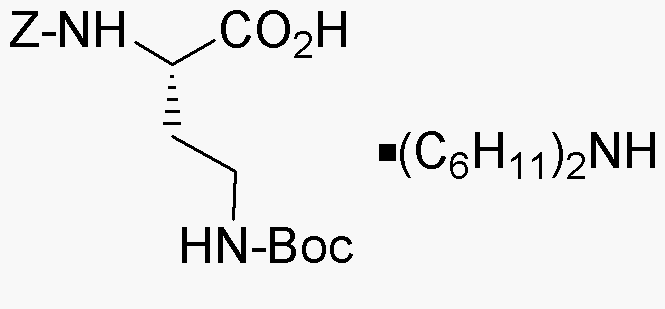Na-Z-Ng-Boc-L-2,4-diaminobutyric acid dicyclohexylammonium salt is widely utilized in research focused on:
- Pharmaceutical Development: This compound serves as an important intermediate in the synthesis of various pharmaceuticals, particularly in the development of drugs targeting neurological disorders due to its ability to cross the blood-brain barrier.
- Peptide Synthesis: It is commonly used in solid-phase peptide synthesis, providing a protective group that enhances the stability and yield of peptide chains, which is crucial for producing therapeutic peptides.
- Biochemical Research: Researchers employ this compound to study enzyme interactions and protein folding, contributing to a deeper understanding of cellular mechanisms and potential therapeutic targets.
- Cosmetic Formulations: The compound is explored in cosmetic chemistry for its potential to improve skin hydration and elasticity, making it a valuable ingredient in anti-aging products.
- Material Science: It is investigated for its role in developing new materials with enhanced properties, such as improved thermal stability and mechanical strength, which can be applied in various industrial applications.
General Information
Properties
Safety and Regulations
Applications
Na-Z-Ng-Boc-L-2,4-diaminobutyric acid dicyclohexylammonium salt is widely utilized in research focused on:
- Pharmaceutical Development: This compound serves as an important intermediate in the synthesis of various pharmaceuticals, particularly in the development of drugs targeting neurological disorders due to its ability to cross the blood-brain barrier.
- Peptide Synthesis: It is commonly used in solid-phase peptide synthesis, providing a protective group that enhances the stability and yield of peptide chains, which is crucial for producing therapeutic peptides.
- Biochemical Research: Researchers employ this compound to study enzyme interactions and protein folding, contributing to a deeper understanding of cellular mechanisms and potential therapeutic targets.
- Cosmetic Formulations: The compound is explored in cosmetic chemistry for its potential to improve skin hydration and elasticity, making it a valuable ingredient in anti-aging products.
- Material Science: It is investigated for its role in developing new materials with enhanced properties, such as improved thermal stability and mechanical strength, which can be applied in various industrial applications.
Documents
Safety Data Sheets (SDS)
The SDS provides comprehensive safety information on handling, storage, and disposal of the product.
Product Specification (PS)
The PS provides a comprehensive breakdown of the product’s properties, including chemical composition, physical state, purity, and storage requirements. It also details acceptable quality ranges and the product's intended applications.
Certificates of Analysis (COA)
Search for Certificates of Analysis (COA) by entering the products Lot Number. Lot and Batch Numbers can be found on a product’s label following the words ‘Lot’ or ‘Batch’.
*Catalog Number
*Lot Number
Certificates Of Origin (COO)
This COO confirms the country where the product was manufactured, and also details the materials and components used in it and whether it is derived from natural, synthetic, or other specific sources. This certificate may be required for customs, trade, and regulatory compliance.
*Catalog Number
*Lot Number
Safety Data Sheets (SDS)
The SDS provides comprehensive safety information on handling, storage, and disposal of the product.
DownloadProduct Specification (PS)
The PS provides a comprehensive breakdown of the product’s properties, including chemical composition, physical state, purity, and storage requirements. It also details acceptable quality ranges and the product's intended applications.
DownloadCertificates of Analysis (COA)
Search for Certificates of Analysis (COA) by entering the products Lot Number. Lot and Batch Numbers can be found on a product’s label following the words ‘Lot’ or ‘Batch’.
*Catalog Number
*Lot Number
Certificates Of Origin (COO)
This COO confirms the country where the product was manufactured, and also details the materials and components used in it and whether it is derived from natural, synthetic, or other specific sources. This certificate may be required for customs, trade, and regulatory compliance.


